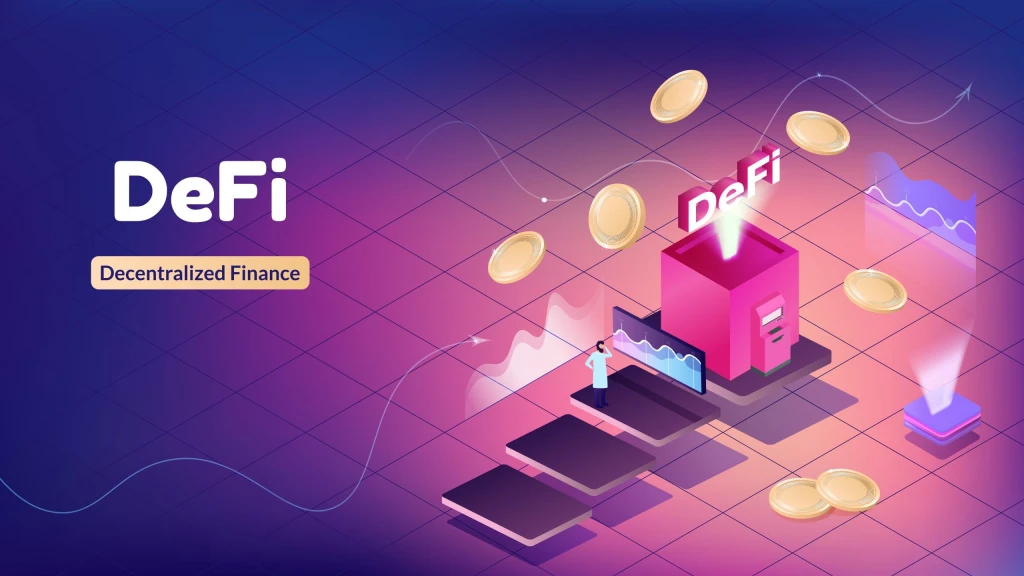What is Decentralized Finance (defi)

One of the latest trends in the crypto industry is DeFi. Surely you have heard of this term. What is DeFi, you may ask? In this article, we will discuss what it is in detail and figure out why this trend has become so popular.
What is Decentralized Finance (defi)?
DeFi is an abbreviation for Decentralized Finance. Talking about defi meaning, we should say that these are financial services that are provided without human participation and do not have a single center for management. Typically, such services are developed using blockchain, which includes cryptocurrencies, stablecoins, and decision-making ecosystems.
The idea behind the DeFi definition is often called Open Finance. It is about giving users full control over their assets and providing financial services to all people in the world, especially to those who can’t or don’t want to use banks.
Such results can be achieved by creating a new ecosystem of financial apps built on open-source software and using decentralized networks. This architecture reduces the need for any central regulatory authority or intermediaries that profit from fees.
The main idea of a decentralized financial system is that services such as currency platforms, transfers, insurance, and lending, which often occur through intermediaries such as exchanges or banks, in De-Fi are carried out directly between the parties in an automatic mode. This is possible thanks to programmable self-executing agreements encoded in the blockchain, known as smart contracts.
How does DeFi work?
What is decentralized finance and how does it work? DeFi leverages peer-to-peer networks, security protocols, software innovations, and hardware advancements to bypass traditional parties such as banks and financial service providers. They typically charge fees from users for their services but DeFi utilizes blockchain technology to minimize reliance on them.
Blockchain
Blockchain is a technology for encrypting and storing data (register) that is distributed across many computers connected to a common network. This is a digital database of information that reflects all completed transactions. All records in the blockchain are presented in the form of blocks, which are interconnected by special keys. Moreover, each new block contains data about the previous one.
Blockchain is used to store and transmit digital data. These can be both financial and non-financial assets (for example, images or objects from the video game industry). Blockchain allows you to assign an asset unique information about its ownership by a specific person. Moreover, such information cannot be falsified, deleted, or changed unnoticed.
By using digital wallets that communicate with blockchains, individuals possess private keys serving as access codes to tokens or cryptocurrencies, akin to digital passwords. These keys grant them control over virtual assets representing value. Transferring ownership involves 'sending' a specified amount to another party through a wallet, which then generates a distinct private key for the recipient, ensuring the security of their token ownership. The blockchain's architecture guarantees the irreversibility of such transfers.
Applications
DeFi applications serve as user-friendly gateways to interact with blockchain, empowering individuals to engage in financial activities like purchases, loans, trading, and more without intermediaries. These software programs, accessible on devices such as personal computers, tablets, and smartphones, streamline the DeFi experience. Without these apps, users would need to navigate complex command line interfaces or terminals within their device's operating system.
By offering intuitive interfaces, DeFi apps automate transactions between users and present a range of financial options. For instance, users can easily facilitate loans with interest rates and collateral requirements by selecting appropriate settings within the interface. Similarly, borrowers can explore various loan providers, which may include traditional banks or individual lenders willing to extend crypto loans based on mutually agreed terms.
Furthermore, some applications enable users to specify their service preferences and connect with counterparties globally. Leveraging the decentralized nature of blockchain, individuals can access and provide financial services across borders seamlessly.

Cryptocurrency
Any crypto operates based on blockchain. The technology is used both in the emission of new currencies and the generation of new tokens (coins) and in settlements with existing ones. There are now more than 300 cryptocurrency projects in the world. The most popular ones besides Bitcoin are Ethereum, Ripple, Tether, Litecoin, and Dogecoin.
Payments in crypto are used by payment systems PayPal and Square and one of the largest international banks JP Morgan. Cryptocurrencies tend to have high volatility. There are specialized centralized and decentralized cryptocurrency exchanges for investing in cryptocurrencies.
Smart Contracts
Blockchain operates on the digital smart contracts, data about which is protected by encryption. Their key difference is the automatic control and implementation of contract clauses. If the conditions are met, the contract ends automatically, without additional actions or the participation of lawyers. Smart contracts allow you to track the entire chain of transactions, which reduces or completely eliminates the possibility of illegal activities.
Is Bitcoin Part of Decentralized Finance?
Bitcoin is often considered a foundational element of decentralized finance (DeFi). DeFi refers to a movement that aims to create an open, permissionless, and transparent financial system developed on blockchain. While Bitcoin itself is not a DeFi project in the traditional sense, it shares many characteristics with DeFi protocols.
Bitcoin operates on a decentralized network of nodes that validate transactions and secure the network through consensus mechanisms like proof of work. It allows users to send and receive value without the need for banks and other middle parties. This decentralized nature aligns with the principles of DeFi, which seeks to eliminate the reliance on centralized institutions in the financial system.
Also, Bitcoin can be used in many DeFi apps and platforms. For example, users can leverage Bitcoin as collateral to borrow other cryptocurrencies or stablecoins in lending protocols. They can also participate in decentralized exchanges (DEXs) that allow for peer-to-peer trading of digital assets, including Bitcoin.
Overall, while Bitcoin is not a DeFi project per se, its decentralized nature and utility in DeFi apps make it an integral part of the broader finance system.
How DeFi Is Being Used Now
What is the defi and how it is being used today? There are many use cases for DeFi: operational protocols that allow individuals to send money around the world, transfer currency, earn returns on deposits, and borrow or lend money. All these things are not operated from one center.
While cryptocurrencies were introduced to create decentralized financial systems and conduct commerce, DeFi is more concerned with the issuance of money, payments, and storage. This cuts out intermediaries such as banks, giving users complete control over their money. Moreover, decentralized finance goes further. They offer many financial services such as loans, insurance, etc. on a platform that can be accessed by people all over the world.
Traditional Financial Transactions
In the context of DeFi, traditional transactions refer to activities that mirror conventional banking services but are conducted on decentralized platforms using blockchain. These transactions typically involve activities such as borrowing, lending, trading, and investing but they are executed without the need for banks or other similar institutions.
Decentralized Exchanges (DEXs)
Decentralized exchanges (DEX) do not oblige users to store their funds in accounts within the platform and do not require the provision of personal data to conduct transactions.
For the most part, such exchanges only match orders for the purchase or sale of cryptocurrencies. Transactions on these platforms exclude KYC (user identification) procedures and the presence of intermediaries. DEXs provide trading and swap services, data on spot market prices, and lending liquidity, some also allow for issuing and receiving loans, and so on.
Among the most well-known DEXs and exchange protocols today are IDEX, Kyber Network, 0x, AirSwap, Paradex, Loopring, Bancor, dYdX, Uniswap, and 1inch.
Decentralized Insurance
Traditional insurance products protect individuals and businesses against financial losses. DeFi platforms are exploring the concept of decentralized insurance where users pool funds to cover risks and receive payouts automatically when predefined conditions are met.
Liquidity Pools
DeFi offers deposits or pooling to provide liquidity for loans. It is not necessary to fill only the lending platforms with liquidity, because you can provide liquidity for decentralized exchanges yourself and receive a percentage of the commissions that users pay for trading on the platforms.
Speaking about liquidity pools, we should mention the Curve project, the essence of the project is to provide liquidity for cryptocurrency exchanges. By providing their funds to the liquidity pools on the Curve platform, users receive good annual interest on their liabilities.
E-wallets
E-wallets, also known as digital wallets, play a crucial role when we define DeFi ecosystem. They provide users with a secure and convenient way to store, manage, and transact with their digital assets. In the context of DeFi, e-wallets serve as the gateway for users to access various decentralized financial services and interact with decentralized applications (dApps) on blockchain networks. Here are some key aspects of e-wallets in DeFi:
- Secure Storage: E-wallets in DeFi offer secure storage for users' private keys and digital assets. These wallets are typically non-custodial, meaning that users have full control over their funds and are responsible for safeguarding their private keys. By using e-wallets, users can securely store their cryptocurrencies and access DeFi services without relying on centralized entities.
- Interoperability: E-wallets in DeFi are designed to be interoperable with multiple blockchain networks and protocols. Users can manage a diverse range of digital assets across different blockchains within a single wallet interface. This interoperability enables seamless interaction with various DeFi platforms and dApps.
- Transaction Management: E-wallets facilitate the seamless execution of transactions on DeFi platforms. Users can send, receive, and exchange cryptocurrencies directly from their wallets to participate in activities such as lending, borrowing, trading, staking, and yield farming. E-wallets provide a user-friendly interface for managing transactions and monitoring asset balances.
- Integration with DeFi Protocols: Many e-wallets integrate with popular DeFi protocols and dApps to provide users access to a wide range of tools and services. They can connect their wallets to decentralized and lending platforms, liquidity pools, yield aggregators, and other DeFi applications to engage in various financial activities.
- Enhanced Security Features: E-wallets in DeFi often incorporate advanced security features such as multi-factor authentication, biometric authentication, hardware wallet support, and encryption mechanisms to protect users' funds and data from unauthorized access. These security measures help mitigate risks associated with cyber threats and ensure the safe storage of digital assets.
Yield Harvesting
Yield harvesting, also known as yield farming or liquidity mining, is a popular practice in the decentralized finance space that involves leveraging various DeFi protocols to maximize the returns on crypto assets. Yield harvesting allows users to earn passive income by providing liquidity, staking assets, or participating in other activities within DeFi platforms to generate yields or rewards in the form of additional tokens or interest.
Here are some key aspects of yield harvesting:
- One common form of yield harvesting involves providing liquidity to decentralized platforms (DEXs) or automated market makers (AMMs) by depositing pairs of tokens into liquidity pools. In return for providing liquidity, users receive trading fees and additional tokens as rewards based on their share of the pool.
- Yield harvesting can also involve staking assets in DeFi protocols to support network operations, secure the network, or participate in governance activities. Users can earn staking rewards in the form of additional tokens by locking up their assets for a certain period.
- Some platforms specialize in yield aggregation, where they automatically allocate users' funds across multiple DeFi protocols to optimize returns. Users can deposit their assets into these platforms to benefit from automated strategies that maximize yield opportunities across various protocols.
- Yield farmers often employ various strategies to maximize their returns, such as yield compounding, yield swapping, and yield rebalancing. These strategies aim to capitalize on different opportunities in the DeFi ecosystem to generate higher yields on invested assets.
- While yield harvesting can be lucrative, it also comes with risks such as impermanent loss, smart contract vulnerabilities, and market volatility. It is essential for users to conduct thorough research, assess the risks involved, and implement risk management strategies to protect their investments while engaging in yield farming activities.

Stablecoins
Stablecoins are cryptos whose value is pegged to the value of another, less volatile asset (the most popular are pegged to the US dollar). There are centralized and decentralized stablecoins. Decentralized coins are designed to solve the problem of trust in the issuer. These stablecoins are issued algorithmically via over-collateralization, operate on decentralized ledgers, are governed by decentralized autonomous organizations, and their reserves can be publicly verified by anyone.
Non-fungible Tokens (NFTs)
Non-fungible tokens (NFTs) have started to make their way into the DeFi space, offering new opportunities for users to interact with unique digital assets and unlock additional value through innovative apps. The integration of NFTs in DeFi opens up new possibilities for asset tokenization, liquidity provision, and value creation within the decentralized finance ecosystem.
Lending and Borrowing
In traditional finance, individuals and businesses borrow money from banks or other financial institutions. In DeFi, borrowing and lending protocols allow users to borrow funds by providing collateral in the form of cryptocurrencies. Interest rates are determined algorithmically based on supply and demand.
Advantages and Disadvantages of DeFi
To answer the question “What is DeFi crypto?”, we should talk about the advantages of the decentralized finance system:
- With decentralization comes greater transparency. Since the distributed ledger, which contains info about all actions performed on the blockchain network, is shared by everyone, the network data is available for public viewing. The crypto principles underlying the blockchain ensure that data is recorded after its authenticity has been verified. For customers, the transparency that DeFi applications provide can be a key benefit. It can improve due diligence and help people identify and avoid potential financial fraud and dangerous business practices.
- Through the clever use of cryptography and consensus algorithms such as Proof-of-Work, blockchain technology achieves true immutability. This ensures that tampering with records stored on the blockchain network is virtually impossible. Combined with the features already discussed, this creates a level of security that is difficult or impossible to achieve through traditional means.
- DeFi apps bring the inherent benefits of blockchain to the financial sector while aiming to provide user-friendly interfaces for a seamless user experience. Also, the use of smart contracts like dApps provides an additional layer of protection against malicious actors and fraudulent transactions.
- Blockchain enables interoperability by connecting different blockchain systems and guarantees seamless cross-chain transactions. The decentralized environment of blockchain allows for the transfer of control from a central authority to a distributed network.
- Decentralization gives users the benefit of a trust-free environment, reduces vulnerability, and improves data consistency.
- Blockchain allows its users to own their digital assets by providing the right to access and control a private key.
Most of the discussions surrounding decentralized finance these days largely mean only advantages. However, it is important to get a balanced view of the pros and cons to properly assess its potential. In fact, most of the problems and risks associated with a DeFi project primarily relate to the technologies with which it is associated. Blockchain-related issues are generally responsible for DeFi's shortcomings. Here's a quick overview of some of the critical situations you may encounter when implementing DeFi:
- Scalability. DeFi projects undoubtedly have the potential to bring financial inclusion to a wider segment of the population. However, they face huge challenges in blockchain scalability from various perspectives. First of all, confirming DeFi transactions takes an incredibly long time. At the same time, transactions on protocols can become very expensive during busy periods. For example, Ethereum can process almost 13 transactions per second when fully loaded. In contrast, centralized DeFi counterparts can process thousands of transactions over this period of time. Cardano's third-generation blockchain has already achieved transaction speeds of over 250 transactions per second (TPS), compared to 13 TPS on Ethereum.
- Uncertainty. Concerns about uncertainty also shape the pros and cons of decentralized finance. For example, if the blockchain hosting a DeFi project is unstable, the project may automatically inherit the instability of the main blockchain. The Ethereum blockchain is currently undergoing a number of changes. For example, mistakes made during the transition from PoW consensus to the new PoS 2.0 system can lead to problems for the platform.
- Liquidity problems. Liquidity is also undoubtedly a critical factor in DeFi-based blockchain projects and protocols. As of October 2020, the total value tied up in DeFi projects is over $12.5 billion. So, it is clear that the DeFi market is not as big as traditional financial systems. Therefore, it can be difficult to trust a sector that is not as large as the regular financial sector.
How to Get Involved with DeFi
Decentralized Finance has been gaining significant traction in the cryptocurrency space, offering users a new way to interact with financial services without the need for traditional intermediaries. If you're looking to get involved with DeFi mining and explore the world of decentralized finance, here are some steps you can take to start your journey:
- Get a crypto wallet. The first step is to set up a cryptocurrency wallet. A crypto wallet is a digital wallet that allows you to securely store, send, and receive cryptocurrencies. There are various types of wallets available, including hardware wallets, software wallets, and mobile wallets. Make sure to choose a wallet that supports the cryptocurrencies you plan to use in decentralized applications.
- Trade digital assets. Once you have set up your crypto wallet, you can start trading digital assets on decentralized exchanges (DEXs) to participate in DeFi markets. DEXs allow users to trade cryptocurrencies directly with one another without the need for a central authority. Popular DEXs like Uniswap, SushiSwap, and PancakeSwap offer a wide range of trading pairs and liquidity pools where you can swap tokens and provide liquidity to earn rewards.
- Look into stablecoins. These are digital assets pegged to stable assets like fiat currencies or commodities, offering price stability and liquidity in the volatile crypto market. By using stablecoins in DeFi protocols, you can access lending and borrowing services, yield farming opportunities, and other financial instruments without being exposed to the price fluctuations of volatile cryptocurrencies. Popular stablecoins like USDC, DAI, and USDT are commonly used in DeFi applications.
- Explore yield farming and liquidity provision. Yield farming involves providing liquidity to decentralized platforms in exchange for rewards like interest, governance tokens, or trading fees. By staking your assets in liquidity pools on platforms like Compound, Aave, or Curve Finance, you can earn passive income and participate in the growth of the DeFi ecosystem. Make sure to research different yield farming strategies and understand the risks involved before committing your assets.
- Participate in governance and DAOs. Many DeFi protocols are governed by decentralized autonomous organizations (DAOs), where token holders can vote on proposals, changes, and upgrades to the platform. By holding governance tokens and participating in DAO governance processes, you can have a say in the development and direction of DeFi projects. Look for platforms that offer transparent governance mechanisms and community-driven decision-making processes.
Getting involved with DeFi offers a unique opportunity to explore innovative financial services, earn rewards, and contribute to the growth of the decentralized finance ecosystem. By following these steps and staying informed about the latest developments in DeFi, you can start your journey into the world of decentralized finance and unlock new possibilities for financial freedom and inclusion.
Conclusion
All the advantages of DeFi lie in the concept of “decentralization”. This attracts an increasing number of people who want to receive a full range of financial services, exchanges, and trade assets without the participation of any intermediaries. Users want to profit from commissions, without disclosing their personal data, to which attackers can gain access, and without centralized structures dictating, and most importantly, constantly changing the rules of the game in their favor.
DeFi is developing rapidly and many participants in classical markets are beginning to look towards such tools. They are interested in their funds working even without active use, but at the same time with decent returns, which banks are not able to provide today.
Decentralized finance is perfect for those who want to store their finances in a decentralized manner and need an alternative banking sector, but do not want/are unable to deal with traditional financial institutions. The issuer and seller of a decentralized financial asset is a technology entrepreneur, not a bank. Under these conditions, the country of residence of the parties to the transaction and local regulation no longer matter.


To write comments, you need to register or log in